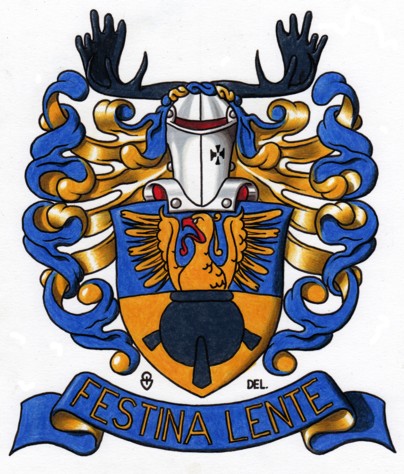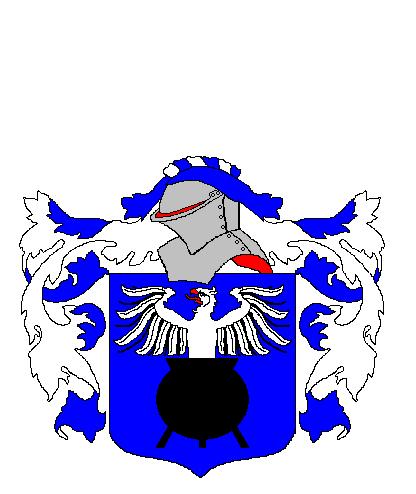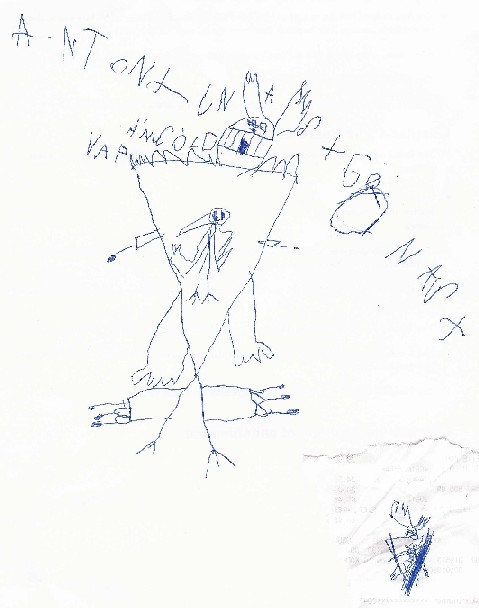How and Why Gunnar Arnell Assumed a Coat of Arms
 Blazon: Per fess azure and or, a demi-eagle
displayed of the last armed gules issuing from a
cauldron sable. Crest: A pair of elk antlers sable.
Assumed by the retired Certified Clinical Engineer and Nebraska Admiral Gunnar Arnell, Eskilstuna, for
himself, his half-brothers and descendants.
Heraldic Artist Davor Zovko, KHS.
Blazon: Per fess azure and or, a demi-eagle
displayed of the last armed gules issuing from a
cauldron sable. Crest: A pair of elk antlers sable.
Assumed by the retired Certified Clinical Engineer and Nebraska Admiral Gunnar Arnell, Eskilstuna, for
himself, his half-brothers and descendants.
Heraldic Artist Davor Zovko, KHS.
Short introduction to heraldry in Sweden
Owning of a Coat of Arms in Sweden does not
imply nobility. From the 14th century Swedish
commoners has adopted Coats of Arms. The
distinction between noble and commoner
in Sweden is given in the helmet. The open
helmet is strictly reserved for the Swedish
nobility, while the closed helmet is the only
alternative for commoners. There is a
government restriction concering this from
1762 still in effect.
No official
registration is kept for commoners' Coats of
Arms. You have a foundation called The Scandinavian Roll
of Arms Foundation (Stiftelsen
Skandinavisk Vapenrulla) which registers
Arms for a fee to ensure the quality
and that no conflicting likeness to
other existing arms is present. For a more
legally binding protection, you can register
your Coat of Arms with the Swedish Patent and
Registration Office (Patent- och registreringsverket,
PRV). The State Herald only
deals with state, provincial, municipal and
other public Coats of Arms, but predecessors in
the older form of National Herald saw the
approbation of a few commoners arms in the 1930'ies.
The Swedish Heraldry Association
has been the driving force in several initiaitives.
The Association publishes new Coats
of Arms in their magazine "Vapenbilden" and in
the database The Heraldic Source
(Heraldiska källan). The most recent initiative
(January 2007) is the Swedish College of Arms
(Svenska Vapenkollegiet), which is a joint
venture with the Swedish National Committee
for Geneology and Heraldry and with participation
from the Swedish Heraldry Society.
In 1998 my son Anton was born. It was
an experience that touched me deeply,
which made me think about the value of family. The
family on my father's side is scattered
around Sweden - I did not even know the
names of all of my cousins and half-cousins.
I thought I owed it to my son to get a grip
on the family and if possible bring it closer
together. I wrote to my paternal uncles and
asked them to tell me bit about the family's
history and the names and addresses of their children.
As I was christened after my grandfather, Jonas
Arnell, I particularly wanted to learn more
about him. I got a reply from my eldest uncle,
who wrote that it actually was impossible that
my grandfather was Jonas Arnell. Grandmother
had broken with him a few years earlier than
my father had known. He stated that my
grandfather actually was grandmother's second
husband Gunnar Persson.
After some consideration, there are a few
indications that this might be true, apart
from the timing. Jonas Arnell was not my eldest
uncle's father. My eldest uncle's Christian name
is the same as his actual father, but was given
the surname Arnell to avoid embarassing questions
in a small-town community. Likewise, it is
probable that my father, as the last of sons,
also was given the name Arnell to avoid
embarrasement, but the same Christian name as his
actual father. Grandmother was separated from but
still married to Jonas Arnell when my father was
born. My father carries the same Christian name as
the new husband, in probable accordance with his
eldest brother. In addition, my father finally
could understand the meaning of a statement made
by Gunnar Persson when my father was a small boy:
"Remember, no matter what anyone else says, I am
your father". In 2004, this got oral confirmation
from the sister of Jonas Arnell, who at that point was
still is alive. Jonas sister told my father and uncles
that Jonas attempted to get custody over his sons, the
second and third of the boys, but not over the first
and fourth (my father), as they were not his sons.
(This
was substantiated in June 2009 when my father received
approporiate documentation from the relevant archive
and was able to get a statement from the widow of his
elder paternal half-brother. Apparantly, Jonas Arnell
was destitute and of poor health. By pointing out him
as the father grandmother was able to secure public
financial support after the divorce. So the whole
affair of who my grandfather is boils down to financial
matters...)
My father found himself being the head of a new
branch of related persons named Arnell. Taking part in
my heraldic interest, he wished to assume a coat
of arms for himself (and his descendants).
The first part of "Arnell" could be the
same word as "örn", meaning eagle. My father was
born in Grytan ("The Cauldron") , a small village
near Östersund in historical province Jämtland.
These two symbols were combined to visualize the
idea of a new branch of Arnells arising from Grytan.
 |
 |
 |
| First version, 1999-2001 |
Alternate draft, 1999 |
Second version, 2001/2002 |
Two similar drafts were made, with different
metals. One draft carried a caulderon sable
and an eagle argent. On a shield azure, this would
refer to the coats of arms of Jämtland,
Östersund and Brunflo who have argent motives on
azure shields. The other draft had an eagle or. The
interpretation in this case could be directed towards
the combination of the historical provinces Jämtland's
and Sudermania's coats of arms, the latter a region
where my father has lived for the greater part of his
life. The azure and or could also be interpreted as
a patriotic expression. My father chose or.
After some consideration about whether the
crest should be eagle wings either in or -
referring to the eagle on the shield - or
in sable, referring to the griffin sable on
the coat of arms of Sudermania.
The choice fell on the latter: sable would
balance the tinctures of crest and lanyard
against the shield's tinctures. In 2001
they were substituted by elk antlers sable,
connected to the life and
heraldry of the historical province Jämtland
and the city of Östersund which includes
Grytan today. There is a family legend
that my grandmothers brother was surprised
by an elk on Crown land and by reflex
unfortuantely shot and killed it on the spot.
He managed to salvage the meat/the evidence
secretly and just barely avoided discovery.
The elk as King of the Swedish forests is a
vital ingredient in Swedish folklore.
The reason for the appearant breach of
heraldic practise in the early versions
by putting azur and sable next to
each other was due to a heraldic article
in a Swedish magazine, which claimed that
black could be placed against both colour
and metal (Sinkadus #14, p. 8, 1988).
In 2002, the heraldic artist Jesper Wasling
suggested that the shield should be per fess
in azure and or, and the coat of Arms was
then published in the #54 issue of Vapenbilden
of the Swedish Heraldry Association.

 LEFT The Coat of Arms of the writer for the Member
Roll of the Swedish Heraldry Association.
Heraldic Artist Ronny Andersen, coloured
by Alexander Ulltjärn.
LEFT The Coat of Arms of the writer for the Member
Roll of the Swedish Heraldry Association.
Heraldic Artist Ronny Andersen, coloured
by Alexander Ulltjärn.
RIGHT The son of the writer, Anton 4,5 years old, wishes for an
eagle displayed without the caulderon (2003-05-13).
The text means "Anton's + Jonas' + Gunnar's Coat of Arms
(Antons + Jnas + Gönnas vapänsöld)
During 2004-2005 I started to make plans
for a coat of arms for all the descendents of
the originator of our extended Arnell family, the
soldier (field ranger) Carl Erik Arnell born 1869
in Lunne, Brunflo, Jämtland. He was
born with the surname Åsell and was probably
given a new surname when he enlisted. The new
arms was supposed to be based on the existing
arms, making my fathers arms personal and at
the same time fitting into a larger context of
Arnell coats of arms. For
different reasons, the project did not take
off, and instead my father decided to extend
the rights to his weapon to all descendents of
Carl Erik Arnell (as well as a few name-bearing
members of the family without blood relation).
With a certain glint in the eye, my
father added the motto Festina Lente (Hurry
Slowly) in 2005. Then it was submitted
for matriculation with the Scandinavian
Roll of Arms where appears as number
684/2006.
Index
Home
All
materials contained on this site are protected by
Swedish copyright law and may not be reproduced,
transmitted, displayed, published or broadcast �
without the prior written permission from the
webmaster. Copyright 1998-2016 Jonas Arnell.
All righ�ts reserved. Some material appear with
specific permission.
 Blazon: Per fess azure and or, a demi-eagle
displayed of the last armed gules issuing from a
cauldron sable. Crest: A pair of elk antlers sable.
Assumed by the retired Certified Clinical Engineer and Nebraska Admiral Gunnar Arnell, Eskilstuna, for
himself, his half-brothers and descendants.
Heraldic Artist Davor Zovko, KHS.
Blazon: Per fess azure and or, a demi-eagle
displayed of the last armed gules issuing from a
cauldron sable. Crest: A pair of elk antlers sable.
Assumed by the retired Certified Clinical Engineer and Nebraska Admiral Gunnar Arnell, Eskilstuna, for
himself, his half-brothers and descendants.
Heraldic Artist Davor Zovko, KHS.



